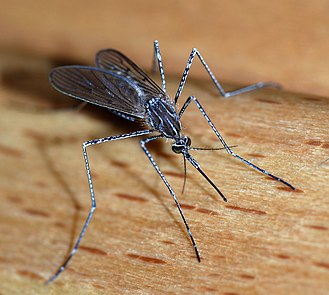Mosquito

Mosquitoes are members of a group of about 3,500 species of small flies within the family Culicidae (from the Latin culex meaning “gnat”). The word “mosquito” (formed by mosca and diminutive -ito)[2] is Spanish for “little fly”.[3][4] Mosquitoes have a slender segmented body, one pair of wings, one pair of halteres, three pairs of long hair-like legs, and elongated mouthparts.
The mosquito life cycle consists of egg, larva, pupa, and adult stages. Eggs are laid on the water surface; they hatch into motile larvae that feed on aquatic algae and organic material. These larvae are important food sources for many freshwater animals, such as dragonfly nymphs, many fish, and some birds such as ducks.[5] The adult females of most species have tube-like mouthparts (called a proboscis) that can pierce the skin of a host and feed on blood, which contains protein and iron needed to produce eggs. Thousands of mosquito species feed on the blood of various hosts — vertebrates, including mammals, birds, reptiles, amphibians, and some fish; along with some invertebrates, primarily other arthropods. This loss of blood is seldom of any importance to the host.
The mosquito’s saliva is transferred to the host during the bite, and can cause an itchy rash. In addition, many species can ingest pathogens while biting, and transmit them to future hosts. In this way, mosquitoes are important vectors of diseases such as malaria, yellow fever, Chikungunya, West Nile, dengue fever, filariasis, Zika and other arboviruses. By transmitting diseases, mosquitoes cause the deaths of more people than any other animal taxon: over 700,000 each year.[6][7] It has been claimed that almost half of the people who have ever lived have died of mosquito-vectored disease,[8] but this claim is disputed, with more conservative estimates placing the death toll closer to 5% of all humans.[9]
The oldest known mosquitoes are known from amber dating to the Late Cretaceous. Three species of Cretaceous mosquito are currently known, Burmaculex antiquus and Priscoculex burmanicus are known from Burmese amber from Myanmar, which dates to the earliest part of the Cenomanian stage of the Late Cretaceous, around 99 million years ago.[10][11] Paleoculicis minutus, is known from Canadian amber from Alberta, Canada, which dates to the Campanian stage of the Late Cretaceous, around 79 million years ago.[12] Priscoculex burmanicus can be definitively assigned to Anophelinae, one of the two subfamilies of mosquitoes alongside Culicinae, indicating the split between these two subfamilies occurred over 99 million years ago.[11] Molecular estimates suggest that the split between the two subfamilies occurred 197.5 million years ago, during the Early Jurassic, but that major diversification did not take place until the Cretaceous.[13]
The mosquito Anopheles gambiae is currently undergoing speciation into the M(opti) and S(avanah) molecular forms. Consequently, some pesticides that work on the M form no longer work on the S form.[14] Over 3,500 species of the Culicidae have already been described.[15] They are generally divided into two subfamilies which in turn comprise some 43 genera. These figures are subject to continual change, as more species are discovered, and as DNA studies compel rearrangement of the taxonomy of the family. The two main subfamilies are the Anophelinae and Culicinae, with their genera as shown in the subsection below.[16] The distinction is of great practical importance because the two subfamilies tend to differ in their significance as vectors of different classes of diseases. Roughly speaking, arboviral diseases such as yellow fever and dengue fever tend to be transmitted by Culicine species, not necessarily in the genus Culex. Some transmit various species of avian malaria, but it is not clear that they ever transmit any form of human malaria. Some species do however transmit various forms of filariasis, much as many Simuliidae do.
